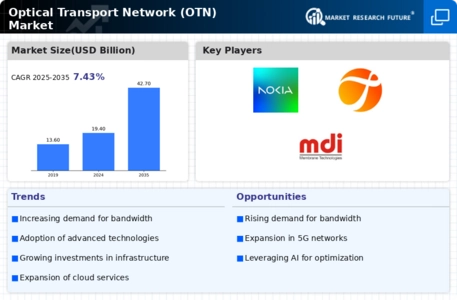Market Trends
Introduction
In 2023, the optical transport network market is experiencing a major change, mainly driven by the following macro-factors: technological innovation, regulatory changes and changing consumer behavior. The growing demand for high-capacity data transport, driven by the development of cloud computing and the Internet of Things (IoT), is pushing the industry to adopt more efficient and scalable optical transport solutions. Regulations aimed at improving the security and availability of the network are also driving the investment in new optical transport technology. As consumers' expectations of uninterrupted and fast Internet access continue to grow, the trend of understanding this market is increasingly important for companies that want to understand the competition and the opportunities for development.
Top Trends
-
Increased Adoption of 5G Networks
The deployment of 5G networks is driving demand for optical transport networks because of their need for high-capacity backhaul. Industry leaders predict that 5G connections will number more than 1 billion by 2025, making it necessary to have a robust OTN. Also, governments are investing heavily in 5G, as with the $9 billion Rural Broadband Plan launched by the U.S. Federal Communications Commission. This trend is putting pressure on OTN suppliers to innovate and to enhance their products and services to support higher data rates. -
Shift Towards Open Networking
Open networks are gaining in importance as operators seek to reduce vendor lock-in and increase flexibility. The use of open standards and disaggregated architectures is gaining ground, and according to reports more than 60% of operators are now exploring open solutions. This trend will lead to greater competition and innovation in OTN technology. And the development of a more open and collaborating vendor community may accelerate the evolution of network capabilities. -
Enhanced Network Automation
The automation of complex OTN networks is becoming a necessity. It is calculated that an automation of OTN networks reduces the operating costs by up to 30 %. Large operators are investing in artificial intelligence and machine learning to optimize the operation and fault management of the network. In the future, automation will lead to a significant reduction in the need for manual intervention, resulting in a faster delivery of services and improved availability of the network. -
Focus on Energy Efficiency
Energy costs are increasing and the environment is under pressure. Energy efficiency is becoming a top priority for OTN operators. The energy consumption of data centers is estimated to be up to 30 % of total operating costs. This is a strong incentive for companies to adopt greener solutions. Green initiatives like the European Union’s Green Deal are pushing for a sustainable telecommunications industry. The development of more energy-efficient optical components and the integration of renewable energy sources are possible future directions. -
Integration of AI and Machine Learning
The use of artificial intelligence and machine learning in the management of OTN systems has increased to improve performance and predict maintenance. Surveys show that 45% of operators are investing in AI-driven solutions to optimize their operations. This integration could lead to improved fault detection and reduced downtime, which will have a significant impact on the quality of the service. As these solutions develop, we can expect them to offer more sophisticated data analysis and decision-making capabilities. -
Expansion of Cloud-Based Services
Cloud services are changing the OTN architecture, and a growing number of companies are migrating to the cloud. In fact, according to research, more than 70% of companies are adopting cloud solutions. This is driving the need for flexible and scalable OTN. The OTN vendors are therefore developing solutions that integrate well with the cloud. OTN may be used to create hybrid cloud solutions that are better connected. -
Rising Demand for High-Speed Connectivity
Moreover, the demand for high-speed connections is growing rapidly, fueled by the growth of data traffic and the proliferation of IoT devices. The projections for 2022 show that the annual volume of Internet traffic will reach 4.8 zettabytes, which requires the development of new OTN solutions. In response, the service providers are expanding their networks to support higher data rates. The trend towards higher speed and more reliable data transmission will probably result in the development of new optical technology. -
Security Enhancements in OTN
Optical transport networks need to be made more secure as cyber-attacks become more sophisticated. According to one survey, 60 per cent of organizations have been subjected to a cyber-attack in the past year, so security is a key consideration for network design. Encryption and other advanced security features are now used to protect data in transit. In the future, the use of distributed ledger technology may be used to provide greater security and transparency. -
Emergence of Software-Defined Networking (SDN)
Software-defined networks are transforming the old OTN by making the network more agile and programmable. Industry research shows that the performance of SDNs can be increased by as much as 50 percent, making them an attractive option for service providers. This trend is encouraging the development of OTN solutions that are more flexible and can adapt to changing requirements. The SDNs of the future will probably be widely used in many sectors, which will improve the overall performance of the network. -
Collaboration and Partnerships
In the OTN world, collaboration between operators, suppliers and research institutes is increasingly important. It has led to the creation of new companies and the setting up of associations. More than 40 per cent of companies questioned have a joint venture or a partnership. This trend is producing a more dynamic environment which can respond quickly to market changes. In the future, strategic alliances may be established to meet new challenges in the telecommunications industry.
Conclusion: Navigating the OTN Competitive Landscape
In 2023 the Optical Transport Network (OTN) market will be characterized by high competition and a large degree of fragmentation, with both incumbent and emerging operators competing for market share. Regionally, the demand for advanced network solutions is growing, especially in the Asia-Pacific and North American regions, where investment in the modernization of the network is growing. The suppliers need to strategically position themselves to benefit from their capabilities in artificial intelligence, automation, and flexibility. The incumbents are concentrating on improving their existing services, while the newcomers are investing in innovation and next-generation technology. In the future, integrating these capabilities will be the key to leadership, as this will allow suppliers to meet the various customer needs and adapt to the constantly changing market.









Leave a Comment